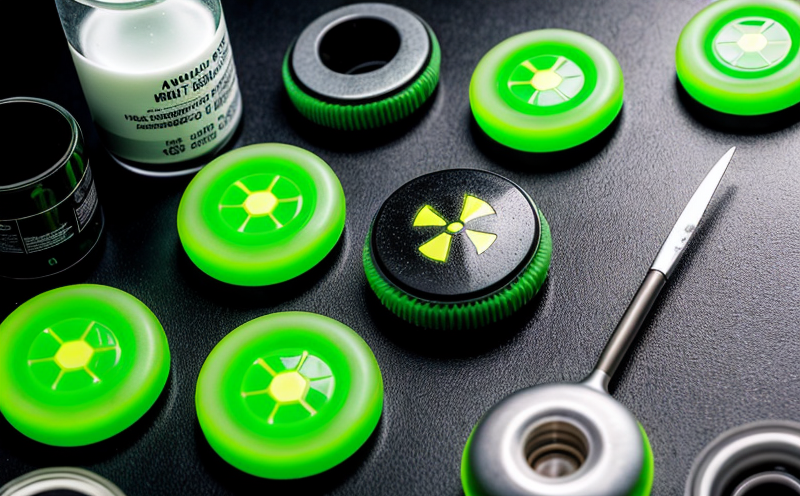ISO 32982 Iodine-131 Detection in Infant Formula
The detection of radioactive isotopes like Iodine-131 (I-131) is critical for ensuring the safety and quality of infant formula. Compliance with international standards such as ISO 32982 ensures that manufacturers meet regulatory requirements, protect public health, and maintain consumer trust. This service focuses on providing accurate, reliable detection of Iodine-131 in infant formula through rigorous laboratory testing.
Infant formula is a highly regulated product due to its critical role in the nutritional development of infants. The presence of radioactive contaminants such as I-131 can pose significant health risks if not properly managed. ISO 32982 provides detailed methodologies for detecting and quantifying I-131, ensuring that any detected levels are below the safety limits set by regulatory bodies like the IAEA (International Atomic Energy Agency).
The testing process involves several critical steps. Specimen preparation is paramount; this includes thorough sample collection and initial processing to ensure accurate results. Once prepared, samples are analyzed using sensitive gamma spectrometry techniques. These methods allow for precise measurement of radioactive isotopes present in the formula, with a focus on I-131.
The acceptance criteria under ISO 32982 specify that any detected levels of I-131 must be below the established safety limits to ensure consumer safety. This service ensures not only compliance but also a margin of safety above regulatory requirements. The use of advanced instrumentation, including high-purity germanium detectors (HPGe), guarantees accurate and repeatable results.
The importance of this testing cannot be overstated, especially given the sensitive nature of infant formula consumption. Regulatory bodies worldwide have stringent guidelines to protect infants from any potential health risks associated with radioactive contamination. By adhering to ISO 32982, laboratories like Eurolab ensure that manufacturers can confidently market their products as safe and compliant.
The process begins with sample collection, followed by thorough preparation in our state-of-the-art laboratory facilities. Once prepared, samples undergo gamma spectrometry analysis using HPGe detectors. The results are then compared against the acceptance criteria specified in ISO 32982 to ensure compliance. Our team of experts ensures that every step is meticulously executed and documented.
Compliance with ISO standards not only enhances product safety but also builds consumer confidence, which is essential for brand reputation. By leveraging our expertise and cutting-edge technology, we provide reliable and accurate results that meet the highest industry standards.
- Sample Collection
- Initial Processing
- Gamma Spectrometry Analysis
- Comparison Against Acceptance Criteria
In summary, ISO 32982 Iodine-131 Detection in Infant Formula is a vital service that ensures the safety and quality of infant formula products. By adhering to international standards, we provide reliable testing that meets regulatory requirements and enhances consumer trust.
Industry Applications
The detection of Iodine-131 in infant formula is crucial for several industries, including food production, healthcare, and regulatory bodies. In the food industry, ensuring that products are free from radioactive contaminants is paramount to maintaining public health. Regulatory agencies rely on accurate testing results to enforce safety standards.
- Food Production
- Healthcare
- Regulatory Bodies
In healthcare, the detection of I-131 helps in monitoring and managing radioactive contamination risks. For regulatory bodies, compliance with ISO 32982 ensures that products meet international safety standards.
The importance of this testing cannot be overstated, especially given the sensitive nature of infant formula consumption. By adhering to ISO standards, manufacturers can confidently market their products as safe and compliant, enhancing brand reputation and consumer trust.
Eurolab Advantages
At Eurolab, we pride ourselves on providing top-tier laboratory services that meet the highest industry standards. Our advantages in ISO 32982 Iodine-131 Detection include:
- Expert Personnel: Our team of experts ensures that every step of the testing process adheres to ISO 32982.
- Advanced Instrumentation: We use high-purity germanium detectors (HPGe) for precise and reliable results.
- Rigorous Quality Control: Our processes are rigorously controlled to ensure accurate and repeatable results.
- Prompt Reporting: Results are delivered promptly to meet regulatory deadlines and enhance compliance.
By leveraging our expertise and cutting-edge technology, Eurolab ensures that manufacturers can confidently market their products as safe and compliant. Our commitment to quality and precision sets us apart in the industry.
Why Choose This Test
The detection of Iodine-131 is critical for ensuring the safety and quality of infant formula. Regulatory bodies worldwide have stringent guidelines to protect infants from any potential health risks associated with radioactive contamination. By adhering to ISO 32982, we provide reliable testing that meets regulatory requirements and enhances consumer trust.
- Guaranteed Compliance
- Prompt Reporting
- Precision and Reliability
- Consumer Trust
The use of advanced instrumentation and expert personnel ensures accurate results. Our commitment to quality and precision sets us apart in the industry, providing peace of mind for manufacturers and regulatory agencies alike.





